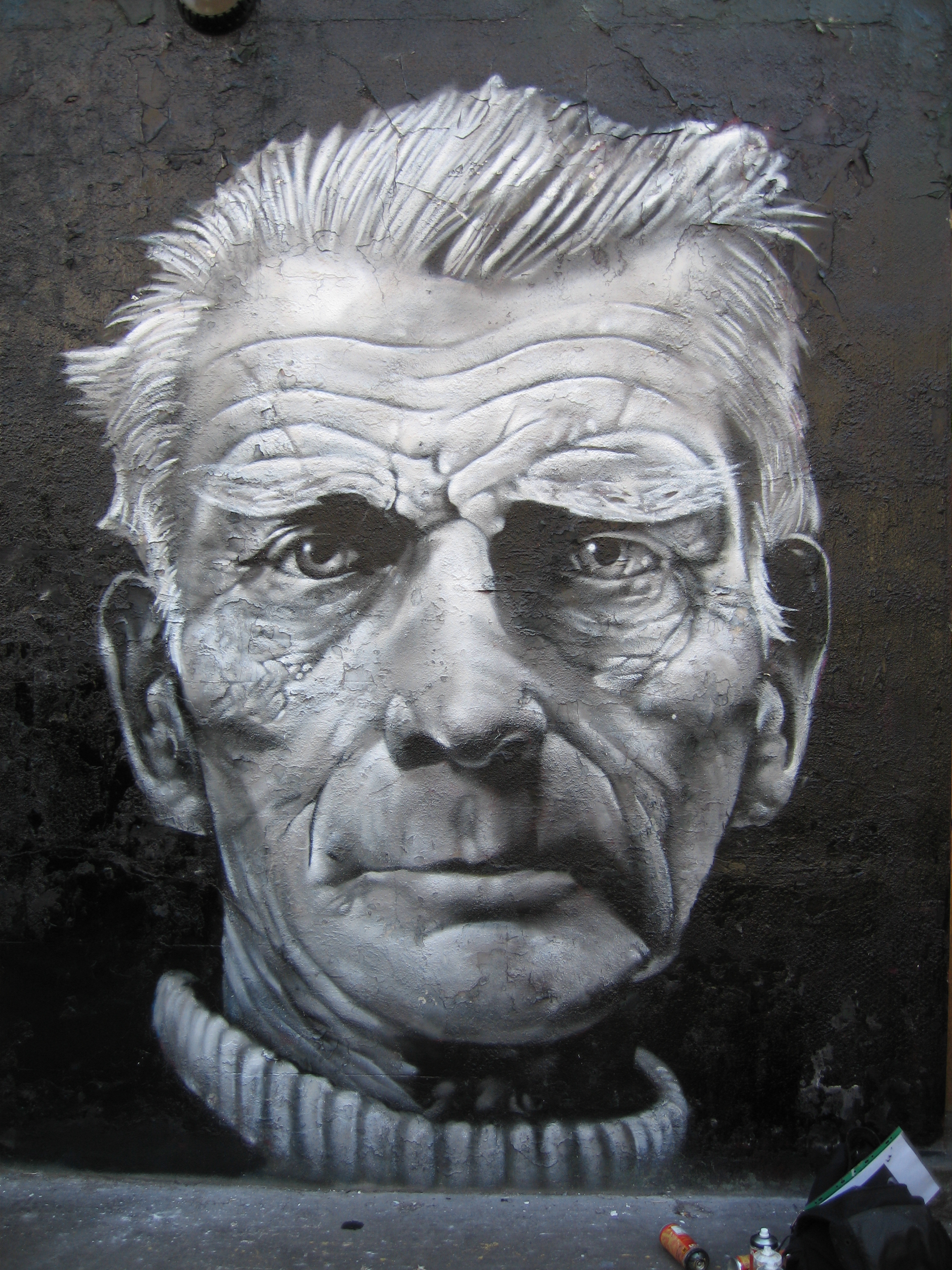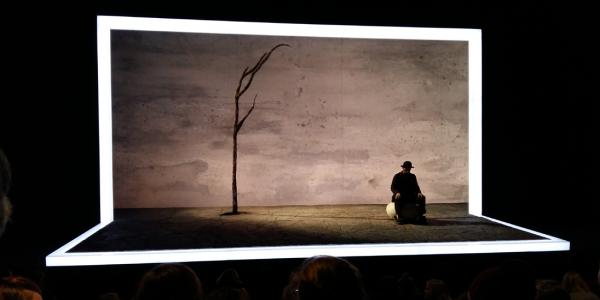Julia A. Walker is associate professor of English and drama.
Samuel Beckett was an elegant writer, mathematically speaking. Seeking to distinguish himself from the great Irish modernist James Joyce, for whom he served as a research assistant during his early years in Paris, Beckett did not practice an additive style, accreting words in waves of associative thought to represent the complex subjectivities of his characters. Rather, he stripped away words until he arrived at the core elements of speech that merely gestured to an intended meaning. In Waiting for Godot, for example, Act I concludes with Gogo asking, “Well, shall we go?” to which Didi replies, “Yes, let’s go.” Beckett’s stage direction reads “They do not move. Curtain.” Here, dialogue and gesture exist in a palpable tension that enacts the concept of “waiting” as somewhere between the movement of asserting one’s will and the ontological stasis of Being. Waiting is thus revealed to be an existential condition of life — a theme figured in the circular action of the play. Quite a bit of philosophical heft packed into only seven words!
Beckett’s “minimalist” style extends beyond his characters’ dialogue to include the spare narratives that structure his novels and plays as well as the theatrical elements that bring his dramas to life on stage. Like a poet (which he also was), he set self-imposed limits on his creative process, stripping the number of characters from his plays over the course of his career: Waiting for Godot features 5; Endgame puts in play 4; Play spotlights 3; Happy Days grounds its action in 2; and Krapp’s Last Tape attests to 1, before the enigmatic mouth in Not I fades to 0.

With geometric precision, Beckett reveals that there is no absolute value of meaning in language, in actions or even in the fact of existence. Like Wittgenstein, he understood meaning to be a function of language use, with the coefficients of vocal inflection, gesture and referential context approaching infinity. This is why he was such a brilliant playwright. Beckett understood how theatre creates meaning though the various “languages” of the stage, including voice and movement. When Clov pushes Hamm’s wheelchair around the perimeter of the room, returning him to dead center, we see Endgame’s chess metaphor play out in the kinesthetic movement of the actors’ bodies as the pawn enacts the authority of his already vanquished King.
We might assume, then, that Beckett’s plays move easily between languages and cultures — vocality and gesture functioning in more or less the same way in each. But Beckett insisted on translating his own work from French into English, from German into English, and from English into French. Moreover, he wrote his plays with specific performers in mind, with Jack MacGowran playing the original Henry in Embers and Joe in Eh Joe, and Billie Whitelaw giving breath and body to characters in Not I, Eh Joe, Footfalls and Rockaby. And Beckett exerted strict control over productions of his plays, trusting directors Alan Schneider and Walter Asmus to interpret them in performance, but famously refusing permission to JoAnne Akalaitis, who set her production of Endgame in a subway tunnel, and to Matin van Veldhuizen, who cast female actors as Godot’s tramps.
Even if his characters and settings remain “universal” (however contested that claim), Beckett’s plays pose interesting problems for translators to solve, as recent performances outside of the Anglo-European context have revealed. In Wu Hsing-kuo’s 2005 production of Godot by the Contemporary Legend Theatre in Taiwan, for example, Beckett’s play was “translated” across languages and cultures in several ways. First, the play’s tragicomic tramps and their vaudeville-esque routines were rendered through the “chou,” or clown, character in Beijing opera, with the actors performing the expected conventions of their jingju roles badly to suggest the characters’ comic failure. Second, to mitigate against an interpretation that this was merely a poor performance, Wu translated the title of the play as Waiting for Guotuo, or “Waiting for Buddha,” where the homonymic quality of “Guotuo” evoked Beckett’s original, even as it shifted the play’s frame of reference from existentialism to an philosophical register that was more recognizable to the production’s target audience, while remaining faithful to the philosophical scope of the source text. As this suggests, Beckett’s minimalist style is a more — not less — complicated proposition for translators, demanding that they take into account language, tone, gesture, frame of reference and context of performance, all with an eye toward preserving the work’s unity. Not an easy task!
RELATED EVENT
“What Is the Word”: Celebrating Samuel Beckett
November 7–8
Washington University
Various locations, see website
The complexities of translating Samuel Beckett’s minimalist style in both text and performance will be the focus of a symposium sponsored by Olin Library’s Special Collections Department on November 7 and 8. Titled “‘What Is the Word’: Celebrating Samuel Beckett,” it features lectures and roundtables on interlingual and intercultural translations of Beckett’s work, as well as transmediations of his textual and performance archives into digital form. A full schedule of events can be found at: https://library.wustl.edu/event/beckett/.





